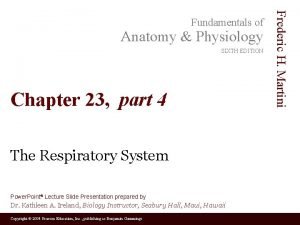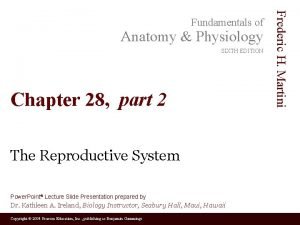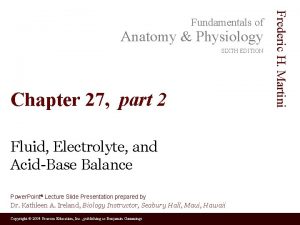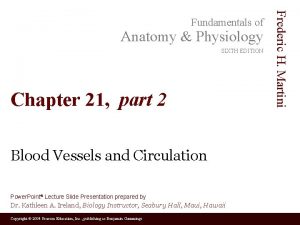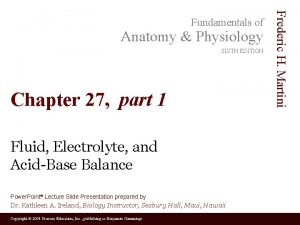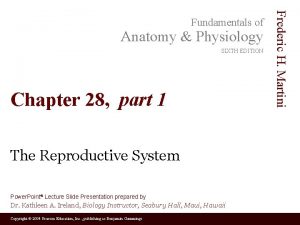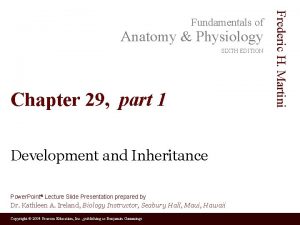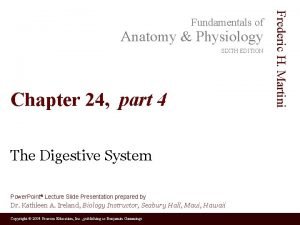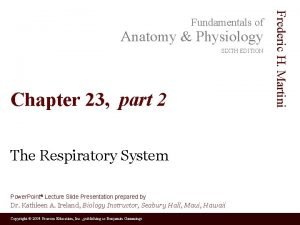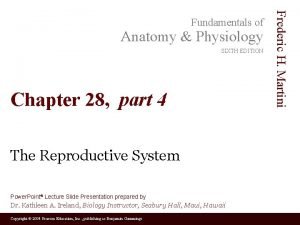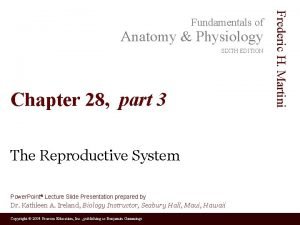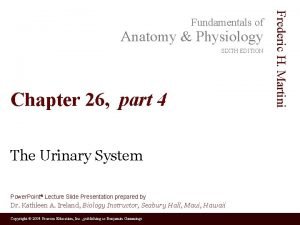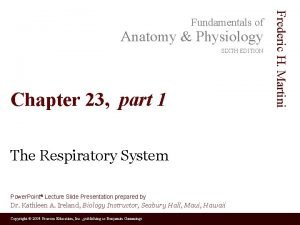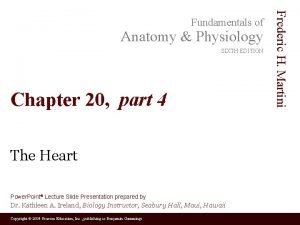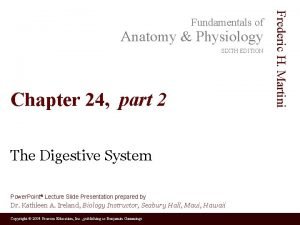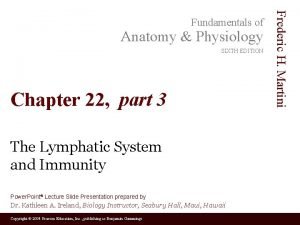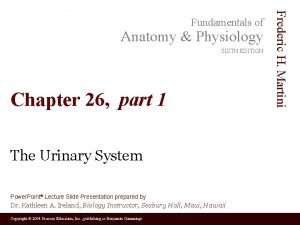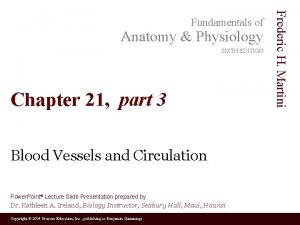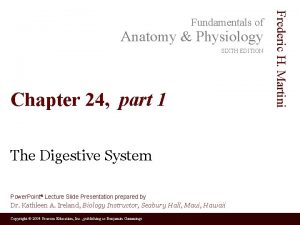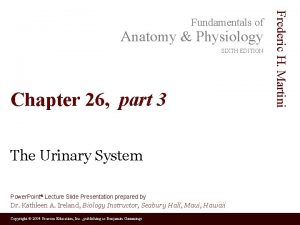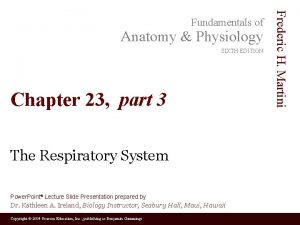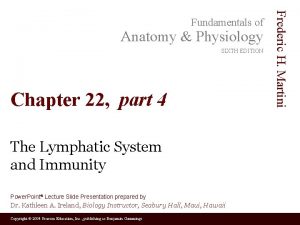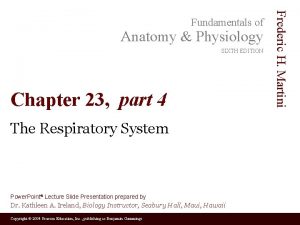Anatomy Physiology SIXTH EDITION Chapter 21 part 1
























- Slides: 24

Anatomy & Physiology SIXTH EDITION Chapter 21, part 1 Blood Vessels and Circulation Power. Point® Lecture Slide Presentation prepared by Dr. Kathleen A. Ireland, Biology Instructor, Seabury Hall, Maui, Hawaii Copyright © 2004 Pearson Education, Inc. , publishing as Benjamin Cummings Frederic H. Martini Fundamentals of

Learning Objectives • Distinguish among the types of blood vessels. • Describe fluid and dissolved material transport into and out of the cardiovascular system. • Describe the factors that influence blood pressure and blood pressure regulation. • Discuss the mechanisms involved in the movement of fluids between capillaries and interstitial spaces. Copyright © 2004 Pearson Education, Inc. , publishing as Benjamin Cummings

Learning Objectives • Describe how blood flow and pressure in tissues is regulated. • Identify the principle blood vessels of each circuit and the areas they serve. • Describe fetal circulation patterns and the changes that occur in these patterns at birth and during aging. Copyright © 2004 Pearson Education, Inc. , publishing as Benjamin Cummings

SECTION 21 -1 The Anatomy of Blood Vessels Copyright © 2004 Pearson Education, Inc. , publishing as Benjamin Cummings

Structure of vessel walls • Walls of arteries and veins contain three distinct layers • Tunic intima • Tunica media • Tunica externa Copyright © 2004 Pearson Education, Inc. , publishing as Benjamin Cummings

Figure 21. 1 A Comparison of a Typical Artery and a Typical Vein Copyright © 2004 Pearson Education, Inc. , publishing as Benjamin Cummings Figure 21. 1

Differences between arteries and veins • Compared to veins, arteries • Have thicker walls • Have more smooth muscle and elastic fibers • Are more resilient Copyright © 2004 Pearson Education, Inc. , publishing as Benjamin Cummings

Arteries • Undergo changes in diameter • Vasoconstriction – decreases the size of the lumen • Vasodilation – increases the size of the lumen • Classified as either elastic (conducting) or muscular (distribution) • Small arteries (internal diameter of 30 um or less) are called arterioles Copyright © 2004 Pearson Education, Inc. , publishing as Benjamin Cummings

Capillaries • An endothelial tube inside a basal lamina • These vessels • Form networks • Surround muscle fibers • Radiate through connective tissue • Weave throughout active tissues • Capillaries have two basic structures • Continuous • Fenestrated • Flattened fenestrated capillaries = sinusoids Copyright © 2004 Pearson Education, Inc. , publishing as Benjamin Cummings

Figure 21. 2 Histological Structure of Blood Vessels Copyright © 2004 Pearson Education, Inc. , publishing as Benjamin Cummings Figure 21. 2

Figure 21. 4 Capillary Structure Copyright © 2004 Pearson Education, Inc. , publishing as Benjamin Cummings Figure 21. 4

Capillary Beds • An interconnected network of vessels consisting of • Collateral arteries feeding an arteriole • Metarterioles • Arteriovenous anastomoses • Capillaries • Venules Copyright © 2004 Pearson Education, Inc. , publishing as Benjamin Cummings

Figure 21. 5 The Organization of a Capillary Bed Copyright © 2004 Pearson Education, Inc. , publishing as Benjamin Cummings Figure 21. 5 a, b

Veins • Collect blood from all tissues and organs and return it to the heart • Are classified according to size • Venules • Medium-sized veins • Large veins Copyright © 2004 Pearson Education, Inc. , publishing as Benjamin Cummings

Venous Valves • Venules and medium-sized veins contain valves • Prevent backflow of blood Copyright © 2004 Pearson Education, Inc. , publishing as Benjamin Cummings

Figure 21. 6 The Function of Valves in the Venous System Copyright © 2004 Pearson Education, Inc. , publishing as Benjamin Cummings Figure 21. 6

Distribution of blood • Total blood volume is unevenly distributed • Venoconstriction maintains blood volume • Veins are capacitance vessels • Capacitance = relationship between blood volume and pressure PLAY Animation: Anatomy Review: Blood Vessel Structure and Function Copyright © 2004 Pearson Education, Inc. , publishing as Benjamin Cummings

Figure 21. 7 The Distribution of Blood in the Cardiovascular System Copyright © 2004 Pearson Education, Inc. , publishing as Benjamin Cummings Figure 21. 7

SECTION 21 -2 Cardiovascular Physiology Copyright © 2004 Pearson Education, Inc. , publishing as Benjamin Cummings

Circulatory Pressure • Circulatory pressure is divided into three components • Blood pressure (BP) • Capillary hydrostatic pressure (CHP) • Venous pressure Copyright © 2004 Pearson Education, Inc. , publishing as Benjamin Cummings

Figure 21. 8 An Overview of Cardiovascular Physiology Copyright © 2004 Pearson Education, Inc. , publishing as Benjamin Cummings Figure 21. 8

Resistance (R) • Resistance of the cardiovascular system opposes the movement of blood • For blood to flow, the pressure gradient must overcome total peripheral resistance • Peripheral resistance (PR) is the resistance of the arterial system Copyright © 2004 Pearson Education, Inc. , publishing as Benjamin Cummings

Overview of Cardiovascular Pressures • Factors involved in cardiovascular pressures include • Vessel diameter • Cross-sectional area of vessels • Blood pressure • Blood viscosity Copyright © 2004 Pearson Education, Inc. , publishing as Benjamin Cummings

Figure 21. 9 Relationships among Vessel Diameter, Cross-sectional Area, Blood Pressure, and Blood Viscosity Copyright © 2004 Pearson Education, Inc. , publishing as Benjamin Cummings Figure 21. 9
 Human anatomy and physiology seventh edition marieb
Human anatomy and physiology seventh edition marieb Anatomy and physiology edition 9
Anatomy and physiology edition 9 Paratubular cyst
Paratubular cyst The sixth sheik's sixth sheep's sick
The sixth sheik's sixth sheep's sick Rubber baby buggy bumpers tongue twister lyrics
Rubber baby buggy bumpers tongue twister lyrics The central sulcus divides which two lobes? (figure 14-13)
The central sulcus divides which two lobes? (figure 14-13) Chapter 1 introduction to human anatomy and physiology
Chapter 1 introduction to human anatomy and physiology Anatomy and physiology chapter 8 special senses
Anatomy and physiology chapter 8 special senses Chapter 13 anatomy and physiology of pregnancy
Chapter 13 anatomy and physiology of pregnancy Anatomy and physiology chapter 2
Anatomy and physiology chapter 2 Chapter 7:9 lymphatic system
Chapter 7:9 lymphatic system Anatomy and physiology coloring workbook figure 14-1
Anatomy and physiology coloring workbook figure 14-1 Chapter 10 blood anatomy and physiology
Chapter 10 blood anatomy and physiology Anatomy and physiology chapter 15
Anatomy and physiology chapter 15 Necessary life functions anatomy and physiology
Necessary life functions anatomy and physiology Holes anatomy and physiology chapter 1
Holes anatomy and physiology chapter 1 Anatomy and physiology chapter 15
Anatomy and physiology chapter 15 Medial and lateral
Medial and lateral Chapter 2 human reproductive anatomy and physiology
Chapter 2 human reproductive anatomy and physiology Appendicular skeleton pectoral girdle
Appendicular skeleton pectoral girdle Chapter 6 general anatomy and physiology
Chapter 6 general anatomy and physiology Cephalic cranial
Cephalic cranial Biochemistry sixth edition
Biochemistry sixth edition Computer architecture a quantitative approach sixth edition
Computer architecture a quantitative approach sixth edition Automotive technology sixth edition
Automotive technology sixth edition

























